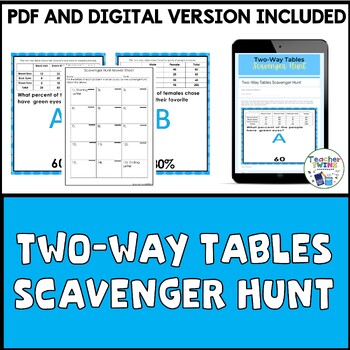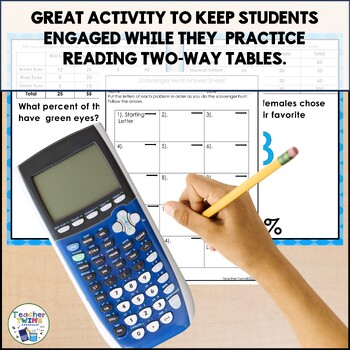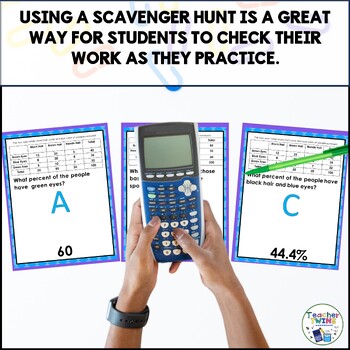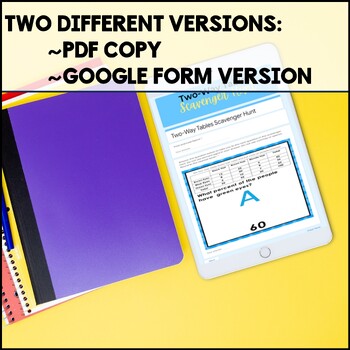Two-Way Tables Scavenger Hunt
- Zip
- Google Apps™
- Easel Activity

What educators are saying
Description
Teaching your students ow to read two-way tables? Need an engaging activity to get students moving while reading two-way tables? Try our Two-Way Tables Scavenger Hunt! This two-way tables scavenger hunt lets students move around while they practice.
This scavenger hunt has 3 different two -way tables with 5 questions from each table.
This activity has 15 two-way table problems.
•12 Find the percent using the two-way table problems.
•3 Find how many using the two-way table problems.
Included in the Two-Way Tables Scavenger Hunt:
- 15 cards with questions to answer using the given two-way table.
- Scavenger hunt recording sheet.
- Answer Key
- Directions for using scavenger hunts.
- Google Form of scavenger hunt (link provided).
Printable Scavenger Hunt
Hang the problem cards around the room and have students do a problem and then search around the room for the answer. When they find the answer, they do that problem next.
Digital Scavenger Hunt
Students do the problems on a Google Form. They cannot go to the next problem until they get the problem correct.
HEAR WHAT TEACHERS ARE SAYING ABOUT THIS SCAVENGER HUNT!
⭐️⭐️⭐️⭐️⭐️ This worked extremely well with my 8th grade Pre-Algebra students!
⭐️⭐️⭐️⭐️⭐️I love how the questions in this scavenger hunt are phrased. It really makes the kids slow down, read, and think. Excellent resource!
⭐️⭐️⭐️⭐️⭐️Good practice and nice to have students moving around the class.
⭐️⭐️⭐️⭐️⭐️Great resources for my students to practice with two-way tables.
⭐️⭐️⭐️⭐️⭐️I used this with my struggling students during reteach hour. It is great that a digital and pdf version are provided so students can choose how to complete the activity in a way that they learn best! Thank you!
Check out these products you might like.
→8th Grade Math Curriculum Bundle
→ Scatter Plots and Two-Way Tables Unit
→ Two-Way TablesColoring Sheet
→ 8th Grade Statistics and Probability Escape to Summer Escape Room Math Review
→8th Grade Statistics and Probability Task Card/Game Review and Assessment
For more Algebra Activities Click Below
Teacher Twins Algebra Activities
For more Digital Activities Click Below
Teacher Twins Digital Activities
For more Scavenger Hunts Click Below
Be sure to follow the Teacher Twins store for new products! CLICK HERE
___________________________________
Copyright © Teacher Twins
Permission to copy for single classroom use only.
Please purchase additional licenses if you intend to share this product.






